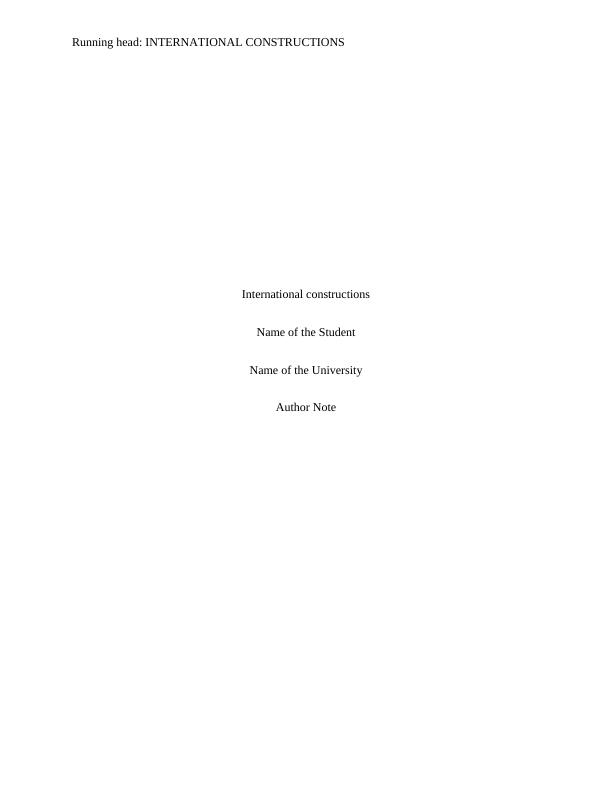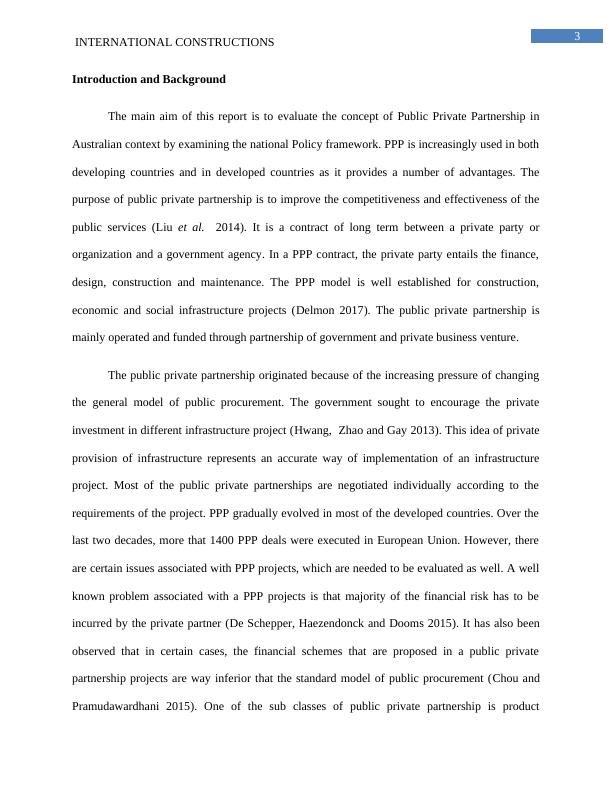Public Private Partnership in Australian and Global Construction/Infrastructure Projects
Added on 2023-06-04
19 Pages5440 Words488 Views
Running head: INTERNATIONAL CONSTRUCTIONS
International constructions
Name of the Student
Name of the University
Author Note
International constructions
Name of the Student
Name of the University
Author Note

1
INTERNATIONAL CONSTRUCTIONS
Executive Summary
A public private partnership is a deal or cooperative arrangement, between the public and the
private sectors. This partnership is typically of a long term nature. Therefore, in this partnership,
one or more private party and government joins together for a long term contract. This type of
partnership is generally made for providing a public asset or service. Majority of the risk in this
type of project bears significant risk and remuneration associated with this project is linked to
their performance. There are a number of benefits of Public private partnership. PPP ensures that
timely provision of public services is offered. It is more effective in resource management in
public. The aim of the report is to evaluate the concept of public private partnership and its use in
Australian context. The public private partnership is mainly based on a principle that both the
parties in the partnership will invest in the project. Public Private Partnership (PPP) is important
as it increases the efficiency of the project by assuring scheduled project completion and increase
in the efficiency of the project. It has been observed that govern public private partnership is
increasingly adopted by both developed and developing countries. There are a number of PPP
projects running in Australia which includes the North East Link project in Melbourne, Peninsula
Link Project in Melbourne and others. Public private Partnership is vital for construction or
infrastructure development projects in Australia. In Australia, PPP is considered for project that
exceeds a budget of $50 million.
INTERNATIONAL CONSTRUCTIONS
Executive Summary
A public private partnership is a deal or cooperative arrangement, between the public and the
private sectors. This partnership is typically of a long term nature. Therefore, in this partnership,
one or more private party and government joins together for a long term contract. This type of
partnership is generally made for providing a public asset or service. Majority of the risk in this
type of project bears significant risk and remuneration associated with this project is linked to
their performance. There are a number of benefits of Public private partnership. PPP ensures that
timely provision of public services is offered. It is more effective in resource management in
public. The aim of the report is to evaluate the concept of public private partnership and its use in
Australian context. The public private partnership is mainly based on a principle that both the
parties in the partnership will invest in the project. Public Private Partnership (PPP) is important
as it increases the efficiency of the project by assuring scheduled project completion and increase
in the efficiency of the project. It has been observed that govern public private partnership is
increasingly adopted by both developed and developing countries. There are a number of PPP
projects running in Australia which includes the North East Link project in Melbourne, Peninsula
Link Project in Melbourne and others. Public private Partnership is vital for construction or
infrastructure development projects in Australia. In Australia, PPP is considered for project that
exceeds a budget of $50 million.

2
INTERNATIONAL CONSTRUCTIONS
Table of Contents
Introduction and Background..............................................................................................3
1. Public Private Partnership................................................................................................4
2. Public Private Partnership in Developed and Developing Countries..............................5
2.1. PPP in Australia........................................................................................................5
2.1.1. Types of PPP in Australia..................................................................................7
2.2. PPP in United States.................................................................................................8
3. PPP in large Construction/Infrastructure Projects...........................................................9
3.1. PPP in global construction projects........................................................................11
4. Risks in PPP...................................................................................................................12
Conclusion and Recommendations....................................................................................14
References..........................................................................................................................15
INTERNATIONAL CONSTRUCTIONS
Table of Contents
Introduction and Background..............................................................................................3
1. Public Private Partnership................................................................................................4
2. Public Private Partnership in Developed and Developing Countries..............................5
2.1. PPP in Australia........................................................................................................5
2.1.1. Types of PPP in Australia..................................................................................7
2.2. PPP in United States.................................................................................................8
3. PPP in large Construction/Infrastructure Projects...........................................................9
3.1. PPP in global construction projects........................................................................11
4. Risks in PPP...................................................................................................................12
Conclusion and Recommendations....................................................................................14
References..........................................................................................................................15

3
INTERNATIONAL CONSTRUCTIONS
Introduction and Background
The main aim of this report is to evaluate the concept of Public Private Partnership in
Australian context by examining the national Policy framework. PPP is increasingly used in both
developing countries and in developed countries as it provides a number of advantages. The
purpose of public private partnership is to improve the competitiveness and effectiveness of the
public services (Liu et al. 2014). It is a contract of long term between a private party or
organization and a government agency. In a PPP contract, the private party entails the finance,
design, construction and maintenance. The PPP model is well established for construction,
economic and social infrastructure projects (Delmon 2017). The public private partnership is
mainly operated and funded through partnership of government and private business venture.
The public private partnership originated because of the increasing pressure of changing
the general model of public procurement. The government sought to encourage the private
investment in different infrastructure project (Hwang, Zhao and Gay 2013). This idea of private
provision of infrastructure represents an accurate way of implementation of an infrastructure
project. Most of the public private partnerships are negotiated individually according to the
requirements of the project. PPP gradually evolved in most of the developed countries. Over the
last two decades, more that 1400 PPP deals were executed in European Union. However, there
are certain issues associated with PPP projects, which are needed to be evaluated as well. A well
known problem associated with a PPP projects is that majority of the financial risk has to be
incurred by the private partner (De Schepper, Haezendonck and Dooms 2015). It has also been
observed that in certain cases, the financial schemes that are proposed in a public private
partnership projects are way inferior that the standard model of public procurement (Chou and
Pramudawardhani 2015). One of the sub classes of public private partnership is product
INTERNATIONAL CONSTRUCTIONS
Introduction and Background
The main aim of this report is to evaluate the concept of Public Private Partnership in
Australian context by examining the national Policy framework. PPP is increasingly used in both
developing countries and in developed countries as it provides a number of advantages. The
purpose of public private partnership is to improve the competitiveness and effectiveness of the
public services (Liu et al. 2014). It is a contract of long term between a private party or
organization and a government agency. In a PPP contract, the private party entails the finance,
design, construction and maintenance. The PPP model is well established for construction,
economic and social infrastructure projects (Delmon 2017). The public private partnership is
mainly operated and funded through partnership of government and private business venture.
The public private partnership originated because of the increasing pressure of changing
the general model of public procurement. The government sought to encourage the private
investment in different infrastructure project (Hwang, Zhao and Gay 2013). This idea of private
provision of infrastructure represents an accurate way of implementation of an infrastructure
project. Most of the public private partnerships are negotiated individually according to the
requirements of the project. PPP gradually evolved in most of the developed countries. Over the
last two decades, more that 1400 PPP deals were executed in European Union. However, there
are certain issues associated with PPP projects, which are needed to be evaluated as well. A well
known problem associated with a PPP projects is that majority of the financial risk has to be
incurred by the private partner (De Schepper, Haezendonck and Dooms 2015). It has also been
observed that in certain cases, the financial schemes that are proposed in a public private
partnership projects are way inferior that the standard model of public procurement (Chou and
Pramudawardhani 2015). One of the sub classes of public private partnership is product

End of preview
Want to access all the pages? Upload your documents or become a member.
Related Documents
Critique of Virtual Project Teamslg...
|10
|4005
|62
Sydney Airport Link Tunnel Procurement Processlg...
|4
|754
|241
Risk Allocation in Public-Private Partnership Infrastructure Projectslg...
|15
|3011
|479
Public-private Partnership Centerlg...
|8
|2775
|11
Construction Research Project Proposal: Risks in Public-Private Partnership Projectslg...
|16
|2524
|469
Procurement Method Reportlg...
|25
|6099
|235
